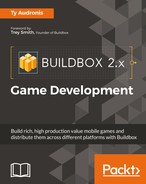Ok, so we didn't quite make a complete game. Many of the assets are still just stock template assets. Also, we haven't made any sound. No optimization of assets was done, and we didn't export the game for distribution. Actually, there is a lot more than these subjects that we didn't cover. But this chapter was not about creating a full game.
This chapter was about making you more familiar with Buildbox's interface, methodologies, and processes, which we've done.
You've learned the basics of the Game Mind Map. You now know what nodes are, and how they tie into each other to make a game flow. You also learned how to make navigation buttons, and how those end up making new output channels on nodes. We've also shown you how to alter your world's physics settings, and what the difference between a world and a scene is. And of course, we've learned about how to apply graphics to objects to make your game look great; as well as how to apply collision shapes to your objects. And finally, we learned about instancing, what it is, and how to use it.
Wow...that was a lot for one chapter. But there's a lot more to go as we move into creating a full and complex game using Buildbox. In the next chapter, we begin developing Ramblin' Rover.
Before you begin, if you haven't downloaded the accompanying content as of yet...please do so now. You're going to need it if you'd like to follow the process. Please refer to the Preface section of this book for download instructions. Included in the content is a fully compiled version of Ramblin' Rover for both Windows and Mac. You may want to play it, just to see what it is we're going to develop here. You may also download the Ramblin' Rover game for your favorite mobile device from its related app store.
